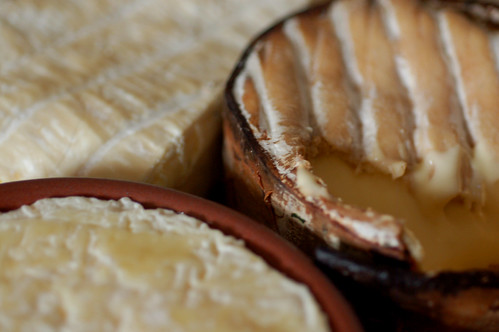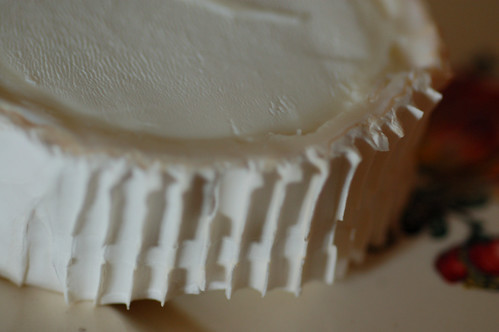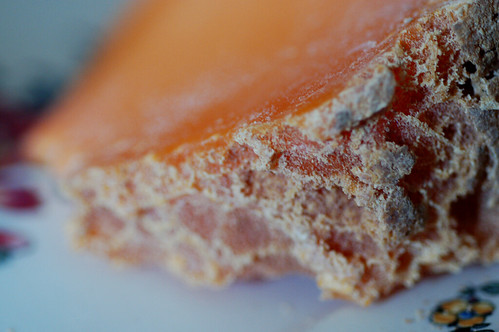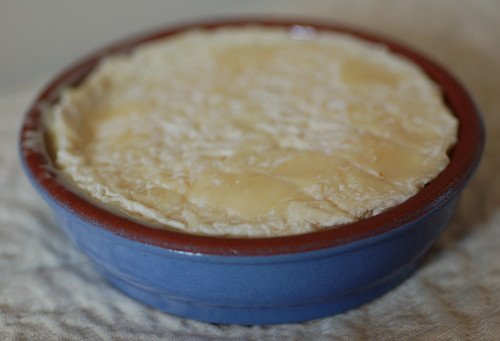"Age is not important unless you're a cheese." -- Helen Hayes

I'm in France right now, spending time with my family. While the reason for this visit (my dad's health) is very serious, we are still in France, and so my sister, stepmother and I are indulging in a Stinky Cheese Jamboree. Both Martha and I love to wander around grocery stores when we travel, and since I can't smuggle our purchases back for blog readers, I'll give you a verbal tasting.

This subtle creamy white cheese is made of goats' milk, and has a lovely sculptural rind that reminds me of the fallen marble columns outside Classical Greek temples. It is called Tomme de Chevre, tomme being a generic word for a wheel of cheese and chevre being the word for goat.

This beautiful aged cheese is Mimolette extra-vieille. This style of cheese was created at the request of King Louis XIV, who wanted a French cheese that resembled Edam. I found this delicious cheese very complex and difficult to describe. It is somewhat chewy, and entirely unlike Cheddar, which is somewhat resembles.

Saint-Felicien moule a la louche cheese is a raw-milk (unpasteurized) cheese made of cow's milk. It is aged for between two and six weeks, and is served in a ceramic tub. Moule a a louche means "molded in a ladle." That's "molded" as in "formed," not as in "moldy." This is a particularly stinky and delicious soft cheese.

This is the most unique cheese on our cheese plate. It s called Ecorce de Sapin, and it is a soft cow's milk cheese that is aged in a wrapper of fir or spruce bark. The cheese is served inside the bark wrapper, and sits on a little wooden plate. Since you cannot cut through the tree bark with a knife, this soft cheese is served with a spoon.
Tomorrow, Anne is taking a much needed break from caring for my dad. She's going to spend a few days at the beach (that's the French Riviera, y'all) with her family. On her way out of town, she'll be dropping me and Martha at the weekly market. I wonder what goodies we'll find there?

Comments
That's the ticket!
Frank (Grumpy)
With your photos, I can almost smell it!!!!
Amazing...
It just occurred to me that one of my most distinct memories of you and Martha together involved stinky cheese...Remember that New Year's Eve wandering around the chilly city after the stinky cheese fondue filled apartment party?
On a lighter note, I got confirmation of my Barack Obama swearing in ceremony tickets. Very Cool!
Annalisa
Thanks for the Helen Hayes quote. I now believe it absolutely.
But also consider what the French have given us aside from cheese; ie:(1)after our win at Saratoga, sending their fleet to force the surrender of the Brits at Yorktown; (2) Their having a revolutiom shortly thereafter to become a democracy; (3) Showing us what was good cheese (4)Sending over the Statue of Liberty to us; (5) more good cheese so we could copy (or try to copy);(6) Holding the trenches from 1914 to 1917 until we woke up and sent over Sgt. York; (7) Added great booze plus cheese to fuse our roaring
20's; (8) Absorbing like a giant sponge the invasion of Adolf (except in the over sensitive South) until we could retool our minds as well as our industry, (and missing all that cheese and wine); (9) and so it comes to modern history; France as a staunch ally in the UN except when confronted by the latest (and lamented President Bush who lied us into the horror of Iraq) Vive La France for knowing a lie when it sees one and thanks over and over for the sharing of your friendship, your wine and your extraordinary ability to create cheeses.
Lisa and Robb, you both know I can't stop when it comes spouting History.
Love, Dad B
A google search on brie and ammonia turns up some interesting information.
Apparently "over-ripe" Brie does smell of ammonia, the smell being produced by the same micro-organism that ripens the cheese in the first place.
http://en.wikipedia.org/wiki/Brie_(cheese)
http://www.discusscooking.com/forums/f22/bad-brie-44216.html